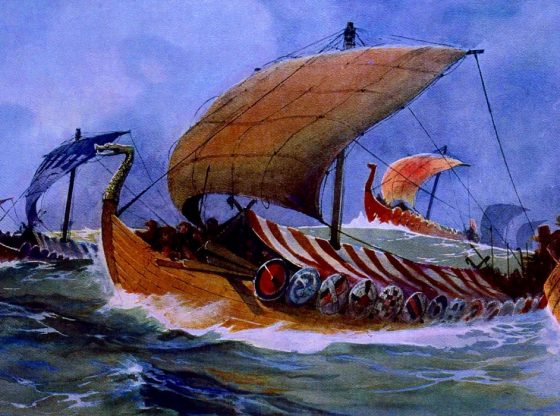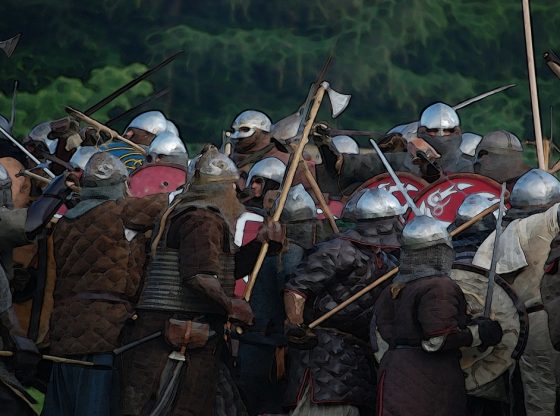
The horned helmets sometimes show up when Vikings are depicted in popular culture. Although most people probably know that the horned helmets belong to the world of myth, today. But was is the origin of the myth?
Neither written sources nor archaeological findings from this period in the history of Scandinavia testify of warriors with horned helmets.
In depictions dating from the Viking age—between the eighth and 11th centuries—warriors appear either bareheaded or clad in simple helmets likely made of either iron or leather.
Archaeologists have yet to uncover a Viking-era helmet embellished with horns. In fact, only one complete helmet that can definitively be called “Viking” has turned up. Discovered in 1943 on Gjermundbu farm in Norway, the 10th-century artifact has a rounded iron cap, a guard around the eyes and nose, and no horns to speak of.
To date, Viking helmets have been excavated from only three sites: Gjermundbu in Norway, Tjele Municipality in Denmark and Lokrume parish on Gotland Island, Sweden. The one from Tjele consists of nothing more than rusted remains of a helmet similar to the Gjermundbu helmet, the same goes for the one from Gotland. It is possible that many of the Viking helmets were made from hardened leather and iron strips, since many Icelandic stories and Scandinavian picture stones tell and show warriors with helmets.
In practical terms, it would also have been a bad idea to attach horns to the helmets because it would have made them less durable. So how did this misconception actually occur?

The horned helmets began to emerge in the 19th century romantic depictions of the Vikings. Art often depicted the Scandinavian Iron Age Warriors with imaginative elements that brought thoughts to the world of the sagas.
Swedish sculptor Gustav Malmström (1887-1980) had horned helmets in his portrayals of the raiders. When Richard Wagner (1813–1883) staged his “Der Ring des Nibelungen” opera cycle in the 1870s, costume designer Carl Emil Doepler (1824–1905) created horned helmets for the Viking characters.
These artists and designers didn’t just make up the idea of horns on helmets, though. Inspiration may well have come from the horned helmets found in bronze ages from other parts of Europe. Many helmets predating the Vikings by at least a century were adorned with antlers, wings and animal horns. These helmets were religious or political power symbols – and the horns had no practical function.

A pair of bronze horned helmets, the Veksø helmets, from the later Bronze Age (dating to c. 1100–900 BC) were found near Veksø, Denmark in 1942. Another early find is the Grevensvænge hoard from Zealand, Denmark (c. 800–500 BCE).

A depiction on a Migration Period (5th century) metal die from Öland, Sweden, shows a warrior with a helmet adorned with two snakes or dragons, arranged in a manner similar to horns. Decorative plates of the Sutton Hoo helmet (6th century) depict spear-carrying dancing men wearing horned helmets, similar to a figure seen on one of the Torslunda plates from Sweden. Also, a pendant from Ekhammar in Uppland in Sweden features the same figure in the same pose and an 8th-century find in Staraya Ladoga, in what is now Russia.

Also, Greek and Roman chroniclers often describe northern Europeans wearing helmets adorned with all manner of ornaments, including horns, wings, and antlers. These were likely only donned for ceremonial purposes by Norse and Germanic priests.











![OpenAI. (2025). ChatGPT [Large language model]. https://chatgpt.com](https://www.illustratedcuriosity.com/files/media/55136/b1b0b614-5b72-486c-901d-ff244549d67a-350x260.webp)
![OpenAI. (2025). ChatGPT [Large language model]. https://chatgpt.com](https://www.illustratedcuriosity.com/files/media/55124/79bc18fa-f616-4951-856f-cc724ad5d497-350x260.webp)
![OpenAI. (2025). ChatGPT [Large language model]. https://chatgpt.com](https://www.illustratedcuriosity.com/files/media/55099/2638a982-b4de-4913-8a1c-1479df352bf3-350x260.webp)








